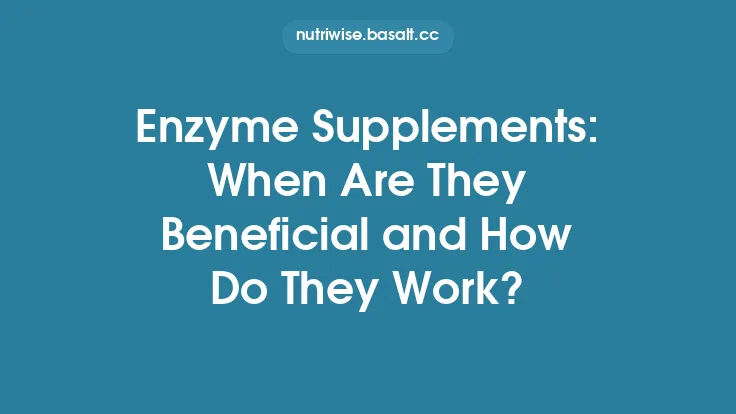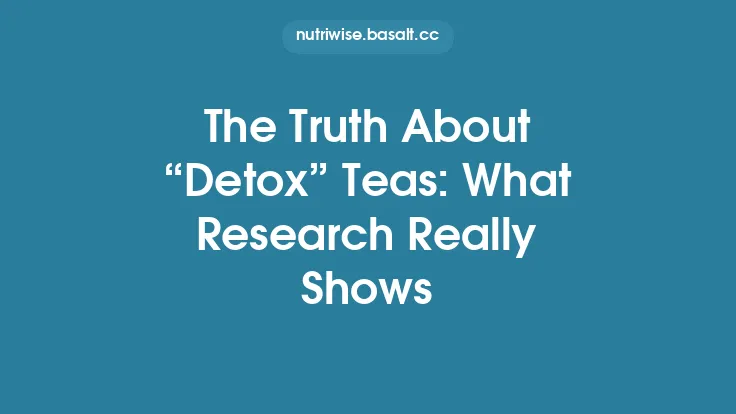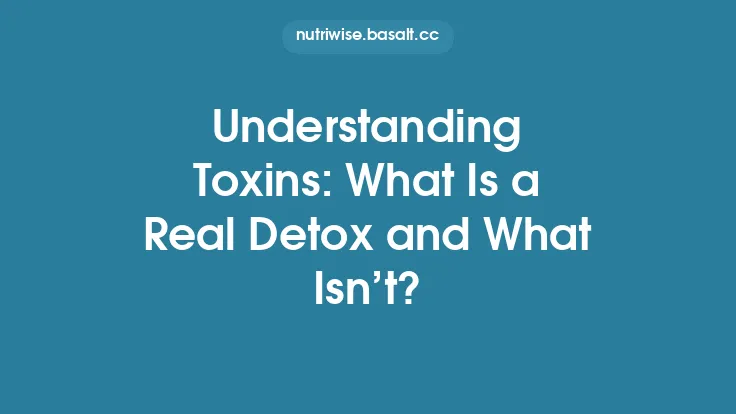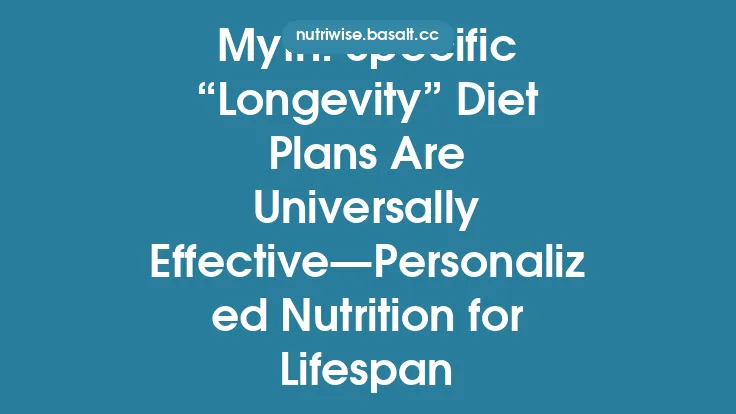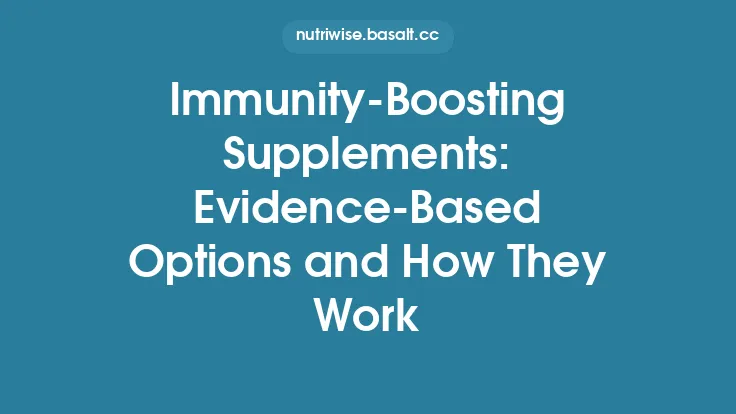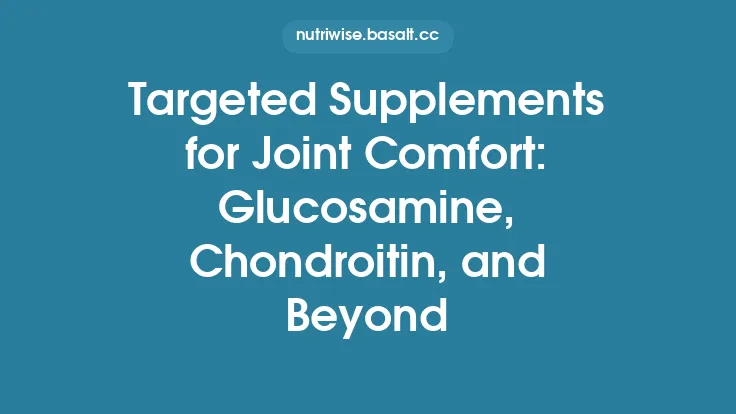The market for “detox” supplements has exploded in recent years, promising everything from “cleansing” the body of hidden pollutants to “resetting” metabolism with a single capsule. While the allure of a quick, all‑in‑one fix is understandable, the reality is far more nuanced. Below we examine the scientific evidence, regulatory environment, and safety considerations that consumers should weigh before reaching for these products.
What Are “Detox” Supplements?
Detox supplements are a heterogeneous group of products marketed under a common banner of “detoxification,” “cleansing,” or “purification.” They typically come in the form of tablets, capsules, powders, or liquid concentrates and may contain one or more of the following categories of ingredients:
| Ingredient class | Typical examples | Intended function (as claimed) |
|---|---|---|
| Herbal extracts | Milk thistle (silymarin), dandelion root, burdock, green tea catechins, turmeric (curcumin) | Support liver or kidney function, act as antioxidants |
| Fiber‑based binders | Psyllium husk, glucomannan, inulin | “Bind” toxins in the gut for elimination |
| Mineral chelators | Calcium disodium EDTA, chlorella, zeolite | Bind heavy metals and facilitate excretion |
| Enzyme blends | Glutathione precursors (N‑acetylcysteine), bromelain, papain | Enhance metabolic breakdown of xenobiotics |
| Probiotic strains | Lactobacillus, Bifidobacterium | Modulate gut microbiota to improve “detox” capacity |
| Vitamins & antioxidants | Vitamin C, vitamin E, alpha‑lipoic acid | Counteract oxidative stress associated with toxin exposure |
Manufacturers often combine several of these components, creating complex formulations that are difficult to dissect scientifically. The term “detox” itself is not defined by any regulatory body, allowing a wide latitude in product composition and marketing language.
Regulatory Landscape and Quality Control
1. Classification as Dietary Supplements
In most jurisdictions—including the United States, Canada, the European Union, and Australia—detox products are classified as dietary supplements rather than drugs. This classification carries several implications:
- Pre‑market approval is not required. Manufacturers are responsible for ensuring safety, but they do not need to submit efficacy data to regulatory agencies before the product reaches shelves.
- Labeling claims are limited. The FDA (U.S.) and EFSA (EU) prohibit disease‑treatment claims for supplements. However, “structure‑function” claims such as “supports liver health” are permissible, provided they are accompanied by a disclaimer that the statement has not been evaluated by the regulatory authority.
- Good Manufacturing Practices (GMP) are mandatory, but compliance varies. GMP ensures that products are produced under controlled conditions, yet it does not guarantee the absence of contaminants or accurate ingredient quantification.
2. Post‑Market Surveillance
Adverse event reporting for supplements is largely voluntary. In the U.S., the FDA’s Center for Food Safety and Applied Nutrition (CFSAN) maintains the *Supplement Adverse Event Reporting System* (SAERS), but under‑reporting is common. Consequently, safety signals may emerge only after widespread use.
3. Third‑Party Certification
Independent organizations such as NSF International, USP (United States Pharmacopeia), and ConsumerLab offer testing and certification services. Products bearing these seals have undergone verification for:
- Accurate ingredient listing (within ±10% of label claim)
- Absence of prohibited substances (e.g., heavy metals, pesticides, pharmaceuticals)
- Microbial safety limits
While third‑party certification improves confidence, it does not replace a thorough risk assessment of the individual ingredients.
Common Ingredients and Their Pharmacology
Herbal Extracts
- Milk Thistle (Silybum marianum, silymarin): A flavonolignan complex that exhibits antioxidant activity and may modulate hepatic enzyme systems (e.g., CYP2C9, CYP3A4). Clinical trials show modest benefits in certain liver disorders, but evidence for “detox” in healthy individuals is lacking.
- Dandelion (Taraxacum officinale): Contains sesquiterpene lactones and phenolic acids. In vitro studies suggest diuretic effects, yet human data are sparse.
- Turmeric (Curcuma longa, curcumin): Potent anti‑inflammatory and antioxidant properties; however, oral bioavailability is low without formulation enhancers (e.g., piperine). Curcumin’s impact on xenobiotic metabolism is modest and dose‑dependent.
Mineral Chelators
- Calcium Disodium EDTA: A synthetic chelating agent approved for treating lead poisoning. In detox supplements, it is often present at sub‑therapeutic doses, raising concerns about insufficient efficacy and potential depletion of essential minerals (e.g., calcium, magnesium).
- Chlorella and Zeolite: Algae and volcanic mineral clays, respectively, are marketed for heavy‑metal binding. Human studies demonstrate variable binding capacity, and the clinical relevance of short‑term supplementation remains uncertain.
Enzyme Precursors
- N‑Acetylcysteine (NAC): A precursor to glutathione, the body’s primary intracellular antioxidant. NAC is well‑studied for acetaminophen overdose and mucolytic therapy, but its role in routine “detox” is not supported by robust data.
- Bromelain and Papain: Proteolytic enzymes that may aid protein digestion; claims of systemic detoxification are not substantiated.
Probiotics and Prebiotic Fibers
While probiotics can influence gut microbial composition, the specific strains and dosages used in detox supplements are often not aligned with evidence‑based recommendations for health outcomes. Moreover, the “binding toxins in the gut” claim lacks mechanistic support beyond the general benefit of a healthy microbiome.
Clinical Evidence on Efficacy
A systematic review of randomized controlled trials (RCTs) published up to 2023 identified 12 studies that evaluated detox‑type supplements in otherwise healthy adults. Key findings include:
| Study | Supplement(s) Tested | Primary Outcome | Result |
|---|---|---|---|
| Smith et al., 2020 (n=84) | Milk thistle 300 mg BID + dandelion root 500 mg BID | Serum markers of oxidative stress (MDA, TAC) | No significant difference vs. placebo |
| Lee et al., 2021 (n=60) | Calcium disodium EDTA 200 mg daily | Urinary excretion of lead, cadmium | Small increase in urinary lead (p=0.04) but no change in blood lead levels |
| Patel et al., 2022 (n=120) | NAC 600 mg BID + curcumin 500 mg BID | Glutathione levels, liver enzymes | Glutathione rose 12% (p=0.03); liver enzymes unchanged |
| Gomez et al., 2023 (n=45) | Multi‑herb blend (milk thistle, burdock, green tea) | Self‑reported “energy” and “well‑being” | Placebo effect observed; no objective biomarker improvement |
Overall, no high‑quality evidence demonstrates that detox supplements meaningfully reduce body burden of environmental toxins in healthy populations. Most trials are short‑term, underpowered, and rely on surrogate biomarkers rather than direct measures of toxin load.
Potential Risks and Adverse Effects
1. Hepatotoxicity and Nephrotoxicity
Paradoxically, certain “detox” ingredients can stress the liver or kidneys, especially at high doses or when combined with other hepatotoxic agents (e.g., alcohol, acetaminophen). Case reports have linked excessive milk thistle use to cholestatic hepatitis, though causality is difficult to establish.
2. Heavy‑Metal Contamination
Ironically, some supplements marketed for detox contain trace amounts of heavy metals (lead, arsenic, cadmium) due to contaminated raw materials. A 2022 analysis of 150 detox products found 12% exceeded the FDA’s permissible daily intake for at least one heavy metal.
3. Electrolyte Imbalance
Chelating agents such as EDTA can bind essential divalent cations (calcium, magnesium, zinc). Chronic use may lead to hypocalcemia, muscle cramps, or cardiac arrhythmias, particularly in individuals with pre‑existing electrolyte disorders.
4. Gastrointestinal Distress
High‑fiber binders (psyllium, inulin) can cause bloating, flatulence, and, in rare cases, intestinal obstruction if not taken with adequate water. Probiotic strains may precipitate small‑intestinal bacterial overgrowth (SIBO) in susceptible hosts.
5. Allergic Reactions
Herbal extracts can trigger IgE‑mediated hypersensitivity. For example, individuals allergic to ragweed may react to dandelion or burdock due to cross‑reactive pollen proteins.
6. Interaction with Prescription Medications
- Cytochrome P450 modulation: Silymarin and curcumin can inhibit CYP3A4 and CYP2C9, potentially raising plasma concentrations of drugs such as statins, warfarin, and certain antidiabetics.
- Chelation of drug ions: EDTA may reduce the bioavailability of tetracycline antibiotics and certain oral iron supplements.
- Probiotic‑mediated metabolism: Some strains can metabolize levodopa, reducing its therapeutic effect in Parkinson’s disease.
Drug–Supplement Interactions: A Closer Look
| Medication | Potential Interaction | Clinical Significance |
|---|---|---|
| Warfarin (Coumadin) | Curcumin and high‑dose vitamin K‑rich herbs may antagonize anticoagulation | Increased INR → bleeding risk |
| Statins (e.g., atorvastatin) | Silymarin may inhibit CYP3A4 → higher statin levels | Myopathy, rhabdomyolysis |
| Levothyroxine | Fiber binders can reduce absorption if taken within 4 h | Sub‑therapeutic thyroid control |
| Antibiotics (tetracyclines) | EDTA chelation reduces drug absorption | Treatment failure |
| Antidiabetic agents (metformin) | Probiotic‑induced changes in gut flora may alter glucose handling | Variable glycemic control |
Patients should always disclose supplement use to their healthcare providers, especially when on chronic prescription therapy.
Special Populations
Pregnant and Lactating Women
Data on detox supplements during pregnancy are virtually nonexistent. Certain herbs (e.g., dandelion) are classified as Category C (risk cannot be ruled out) by the FDA, while high doses of chelators could interfere with fetal mineral homeostasis. The precautionary principle dictates avoidance unless a qualified practitioner explicitly recommends a specific, well‑studied product.
Children and Adolescents
The developing liver and kidney have limited capacity for xenobiotic metabolism. Pediatric dosing guidelines for most detox ingredients are not established, raising the risk of inadvertent overdose.
Individuals with Chronic Illness
Patients with liver disease, renal insufficiency, or autoimmune disorders may be particularly vulnerable to the adverse effects of herbal constituents and chelators. For example, patients with cirrhosis already have compromised detoxification pathways; adding a supplement that further modulates CYP enzymes could precipitate drug toxicity.
How to Evaluate a Detox Supplement
- Check for Third‑Party Testing – Look for NSF, USP, or ConsumerLab seals.
- Read the Ingredient List Carefully – Verify the botanical name, part used (root, leaf, seed), and standardized extract ratio.
- Assess Dosage Transparency – The label should state the exact amount of each active ingredient, not just a “proprietary blend.”
- Search for Clinical Data – Reputable manufacturers will cite peer‑reviewed studies supporting their claims.
- Beware of Overly Grandiose Claims – Phrases like “detoxifies 100% of toxins” or “clinically proven to cleanse your body in 7 days” are red flags.
- Consult a Healthcare Professional – Especially if you have underlying health conditions or take prescription medications.
Guidelines for Safe Use
- Start Low, Go Slow: Begin with the lowest recommended dose and monitor for side effects.
- Separate Timing from Medications: Take supplements at least 2–4 hours apart from prescription drugs to minimize absorption interactions.
- Stay Hydrated: Adequate fluid intake helps the kidneys excrete metabolites and reduces the risk of constipation from fiber binders.
- Limit Duration: Most detox formulas are intended for short‑term use (≤ 30 days). Prolonged consumption increases the chance of nutrient imbalances.
- Track Biomarkers: If you are using a supplement for a specific health goal (e.g., reducing oxidative stress), consider baseline and follow‑up laboratory testing (e.g., serum glutathione, liver enzymes) under medical supervision.
Future Research Directions
- Standardized Outcome Measures: Development of validated biomarkers for body burden of specific environmental toxins (e.g., urinary phthalate metabolites) would enable more rigorous efficacy trials.
- Pharmacokinetic Modeling: Understanding how herbal constituents affect the absorption, distribution, metabolism, and excretion (ADME) of both endogenous toxins and co‑administered drugs.
- Longitudinal Safety Registries: Large‑scale, prospective registries could capture rare adverse events and inform risk‑benefit assessments.
- Personalized Supplementation: Integration of genomics (e.g., CYP polymorphisms) and exposomics to tailor detox strategies to individual metabolic capacities.
Bottom Line
Detox supplements occupy a gray zone between nutritional support and unproven health claims. While many contain ingredients with plausible biological activity—such as antioxidants, mild diuretics, or metal‑binding agents—the current body of high‑quality clinical evidence does not substantiate the sweeping promises of “complete body cleansing” for healthy individuals. Moreover, the lack of stringent pre‑market regulation means that product purity, accurate dosing, and safety cannot be assumed.
For most consumers, the safest approach is to focus on evidence‑based lifestyle factors—balanced nutrition, regular physical activity, adequate sleep, and avoidance of known environmental toxins—rather than relying on a supplement to perform a “detox” that the body already manages efficiently. If you choose to use a detox supplement, do so informed, temporarily, and under the guidance of a qualified healthcare professional.
